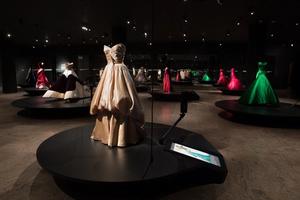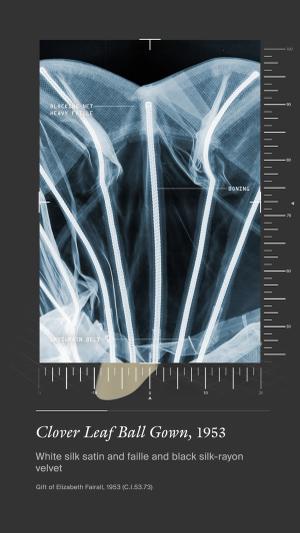
CHARLESJAMES
BEYONDFASHION
Commissioned by the Metropolitan Museum of Art, the exhibition Charles James: Beyond Fashion examines the work of the legendary twentieth-century English-American couturier Charles James. Seventy-five of James’s most notable designs are displayed in two galleries, capturing the designer’s evolution over the course of his prolific career. James’s fascination with complex cuts and seaming led to the creation of signature design elements, including “wrap-over” trousers, figure-eight skirts, body-hugging sheaths, ribbon capes and dresses, spiral-cut garments, and poufs.
The exhibition pairs the sensuous experience of the finished garments with rich analysis of the technical work that lies beneath the surface. The hidden split between glamour and technique in James’s work is revealed by a custom-made integrated system of digital media and optical devices that analyzes the garments and highlights their details. The digital display system enables visitors to cross-reference the artifact in front of them with its curatorial interpretation in real time, slowing the gaze and rewarding careful study.
Fifteen exuberant ball gowns from James’s mature period are featured in the main floor special exhibition galleries. Crafted in the 1950s, the pieces were worn by renowned women such as Austine Hearst, Millicent Rogers, and Dominique de Menil. The garments occupy individual platforms, allowing them to be viewed in the round. The gowns are cast in a different light on each side: seen from the gallery entrance, the pieces’ luxurious and sensual properties are intensified by dramatic spotlights. Their sculptural forms are highlighted, as if flash-frozen while crossing a ballroom floor. The opposite view affords a forensic analysis of each gown’s intricate history and construction, including the instruments from industry, medicine, and museum conservation labs that James often used in their creation.
A series of digital animations narrates, analyzes, and illustrates the unique architecture of each garment. The animations employ dynamic computer models constructed from three-dimensional scans, X rays, microscopy, and original technical research conducted with the assistance of curators at the Costume Institute. In concert with each animation, robotic arms outfitted with video cameras and digital light projectors slowly scan the garments, illuminating the area detailed on-screen. The analyses illustrate James’s consummate understanding of anatomy and the way he used it to create dresses that expertly sculpted and reconfigured the female form.
The Costume Center features a broad selection of garments that spans James’s entire career. The metamorphosis of his day and evening wear over the years is explored in four groupings arranged in an undulating swarm in the center of the room: Spirals and Wraps, Drapes and Folds, Platonic Form, and Anatomical Cut. Four ceiling-mounted robotic boom arms outfitted with video cameras perform a slow overhead dance that traces the garments’ contours, revealing microdetails not visible to the naked eye. The careful folds, spirals, and cuts that James devised are magnified in video projections that replace the gallery walls.
Finally, the Apfel Gallery displays ephemera from James’s life and work, including drawings, pattern pieces, dress forms, jewelry maquettes, scrapbooks, and accessories that illuminate the designer’s biography.
Charles James: Beyond Fashion was curated by Harold Koda, curator-in-charge of the Costume Institute, with Jan Glier Reeder.
| Location The Metropolitan Museum of Art, New York, United States |
| opening8th May 2014 | closed10th August 2014 |
| Team | Elizabeth Diller,Ricardo Scofidio,Kumar Atre,Jaffer Kolb,Matthew Johnson,Bryce Suite,and Alexa Tsien-Shiang |
| Bounding Box | Digital Content Production |
| Parallel Development | Robotics |
| Brooklyn Research | Systems Integration |




